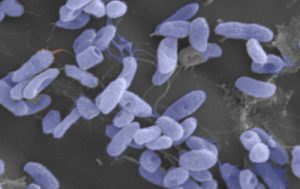In a new study published in Environmental Health Perspectives, a team of scientists including researchers from NOAA’s Atlantic Oceanographic and Meteorological Laboratory (AOML) explore the future risk of waterborne disease in a warming climate. Recently, the European Center for Disease Prevention and Control (ECDC) developed an interactive online tool that can be used to monitor coastal marine areas with environmental conditions favorable to Vibrio growth, aquatic bacteria that can cause human illness. The Vibrio Map Viewer is a real-time global model that uses daily updated remote sensing data to determine marine areas vulnerable to higher levels of Vibrio.

Vibrio are aquatic bacteria that are ubiquitous in warm estuarine and coastal waters with low to moderate salinity. There are many different species that can cause human illness, most associated with ingestion of raw shellfish, wound infections, ear infections, blood poisoning, and cholera. Previous studies have determined that sea surface temperature (SST) and salinity (SSS) are two key environmental factors that influence the presence of this aquatic bacteria, and therefore the number of human infections. The ECDC Vibrio Map Viewer uses daily updated, remotely sensed measures of SST and SSS, specifically in coastal regions where human exposure is likely to occur, to map regions more prone to Vibriogrowth.
By relating environmental data from the ECDC Vibrio Map Viewer in the Baltic Sea region to reported Vibrio cases and readily available epidemiological data in Sweden, scientists were able to more specifically assess the relationship between environmental conditions of coastal water and human Vibrio infections. They found a pronounced exposure-response relationship between SST and Vibrio infections.
Scientist also determined that coastal regions suitable for Vibrio growth are expected to expand over the coming decades as a result of climate change. Climate change projections for SST under two pathways – intermediate or high greenhouse gas emissions scenarios – for the 21st century were used to determine global risk estimates of Vibrio infections in the future. These projections indicated a marked upwards trend in SST during the summer months and an increase in the relative risk of these Vibrio infections in the coming decades.
Monitoring the environmental conditions of coastal waters is critical to human health, given the projected increase in SST and the potential severity of Vibrioinfection moving forward. The ECDC Map Viewer can be used by scientists and coastal managers globally, as a tool to forecast the environmental suitability of coastal waters for aquatic bacteria. These forecasts can then be used to inform public health decision makers for their consideration on public safety warnings. Through this cascade of steps – risk assessment, monitoring of environmental suitability, dissemination and communication, and response – the ECDC Vibrio Map Viewer has the potential to be used as an early warning system for Vibrio infections in coastal waters, anticipated to become more abundant in a warming climate.
Originally Published November 2017 by Sierra Sarkis
